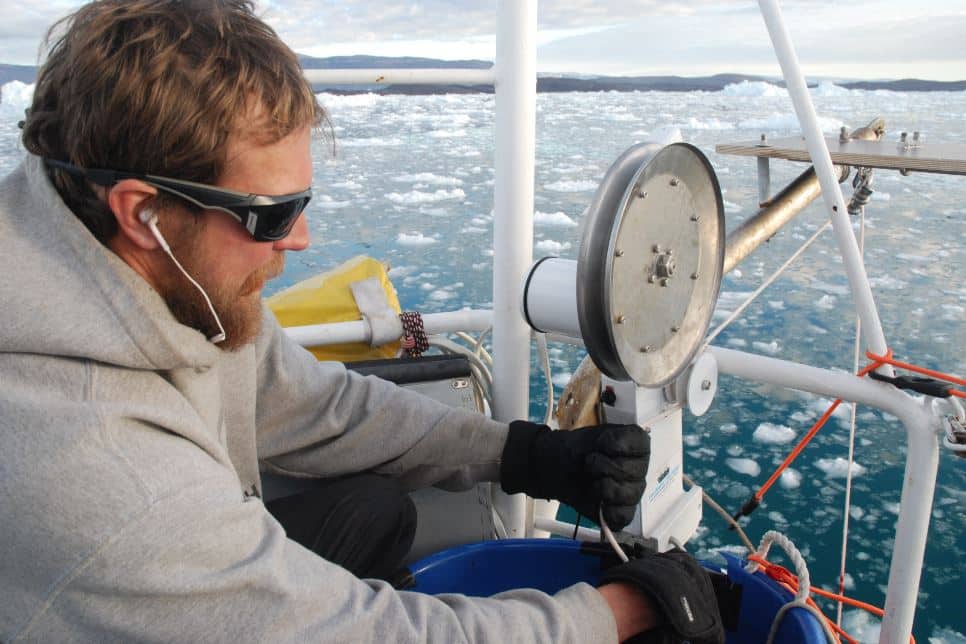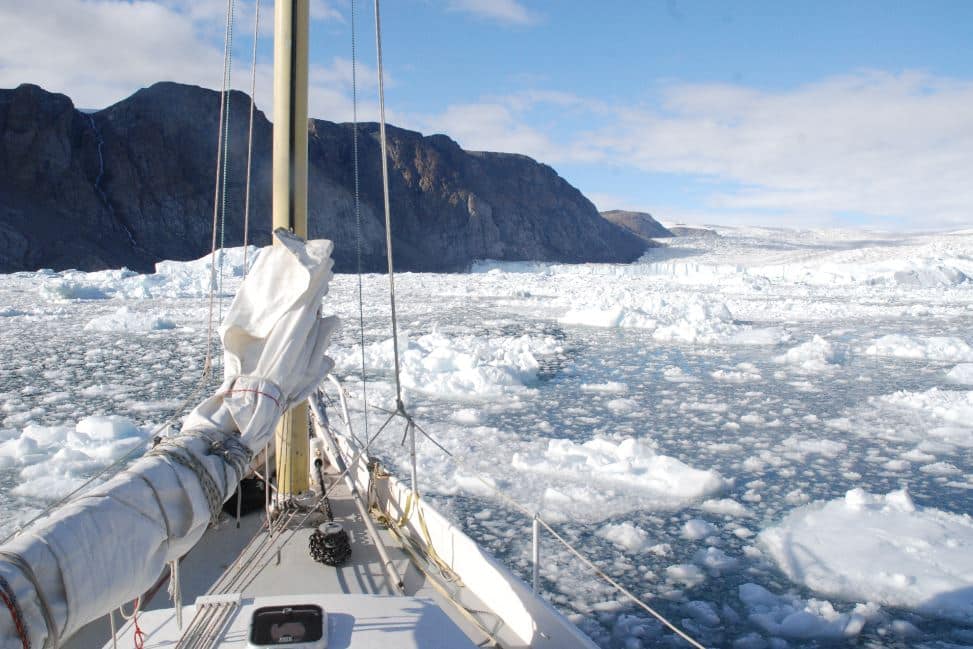The weather has been crazy this year. Normally Northwest Greenland has very little wind in the summer months. If there is strong wind it’s out of the north, but usually it doesn’t blow hard for long. This year its been one storm after another, with all of the winds out of the south. We have had three storms in two weeks that all blew at least 45-50kts. The last storm was so bad it washed away the road in Qaanaaq that leads to the airport; well airstrip is probably a better way to describe it. You know the weather has been bad when roads get washed away. We were only able to collect data for 10 of the first 24 days of our survey for NASA’s OMG program. If that wasn’t bad enough we have also had issues with our survey equipment.
Airmar is one of the largest transducer manufacturers in the world. A transducer is the part of a sonar system that is mounted to the hull that sends and receives the sonars pings. We got a bad transducer from Airmar that is operating at 3.6 ohms when it’s supposed to operate at 10 ohms. What this means is when the sonar tries to push its strong low frequency single through the transducer its motherboard overheats and burns out, killing the sonar in the process. We had $13,000 invested in a sonar system that we can’t use due to this bad transducer. Luckily we do have a backup sonar system. It’s not nearly as good and the data is much more difficult to process afterword but it will map the fjord and get the job done. The whole situation has been very stressful. This region would be difficult enough to map out in prefect conditions, instead we have had storm after storm and faulty survey equipment. Oh well, it wouldn’t be an adventure if everything went as planned.
Our survey isn’t just about mapping the seafloor; it’s really more about finding the warmer Atlantic water that is eating away the edges of Greenland. NASA’s OMG (Ocean Melting Greenland) program is a five year program that is collecting a huge amount of data about the health of the Greenland icecap and its surrounding glaciers. There is a warmer saltier water column, deep in the water, some 200-300 meters down that is coming up from the Atlantic and eating Greenland’s glaciers from underneath. Our job is to map the seafloor so we can find the places where this warmer water might be, then drop a CTD probe to verify it’s there. The CTD can detect t the change of temperature and salinity as it descends towards the bottom. There is a line attached to the CTD, 3,300 feet of line to be exact, that we use to bring the CTD back to the boat. It can take an hour to do one CTD cast; we are doing 130 CTD casts over the course of the survey. The job is made easier by a watermen’s pot puller I mounted to the back of the boat. Usually a pot puller is used to bring crab and lobster pots up from the bottom, but it serves our purpose well.

I get so wrapped up in our issues and our research that I don’t always take the time to appreciate the beauty around me. We were on anchor last week waiting for a storm to begin. We had been there for several hours, I was busy stressing out over the weather and broken equipment when I looked up and realized how beautiful it was. We were anchored at the base of a 3,000 foot cliff with a glacier coming down its side. The cliff itself looked like the view you have looking up at the island in the sky district of Canyonlands National Park (one of my favorite places in the United States). I realized I need to stop stressing out so much and enjoy the scenery.
We have finally gotten a break in the weather a few days ago so we were able to get back to work. We wanted to take full advantage of the light winds so we headed to the iciest part of our survey. A place you can only enter in absolutely calm conditions.
There are many glaciers that feed into Inglefield fjord but many of the largest and most active glaciers are located at the end of the fjord, with the majority of those on the northern side. To make things icier there is an island that is located near the northern side of the end of Inglefield fjord that prevents much of the ice from escaping exacerbating the already icy waters. It’s an iceberg traffic jam mix up, giant bergs, bergy bits, brash ice, you name it, if its ice, it’s there in force. This island I speak of isn’t even supposed to be an island; our charts show that it’s a peninsula. Goes to show how accurate the charts are; it’s definitely an island with at least 1,000 feet of water on all sides of it. In some places you can weave through the ice, in other places there is so much ice that all you can do is push through it. Sometimes the ice is so heavy even pushing through it isn’t an option so you have to turn back unable to map that area.

We operate around the clock and don’t always get much sleep which doesn’t make things any easier. It’s very slow going as we can hardly go faster than 1mph. Since we are constantly pushing ice out of our way with our boat if we go too fast the ice could poke a hole in our steel hull, damage our rudder or break our underwater sensors. Poor Alexander sleeps forward in the V-berth; he can both hear and feel every piece of ice that we hit as we push along through the jumble. Sometimes when we hit a large piece of ice the whole boat jerks hard to one side or the other which can make you lose your balance if you’re not careful. All of this sounds quite dangerous but at 1mph in flat calm conditions it’s no real threat. Just keep an eye on the glaciers so if they calve a large iceberg you’re ready for the ensuing wave and try not to get too close to any giant icebergs that look rotten and ready to roll over.
The worst of that northern area is now mapped out and behind us. We have many other glaciers and sub-fjords to map and will be hard at work for the next two or three weeks. On September 22nd the sun will set for the first time and we need to have the project wrapped up before that happens. Nature has given us a deadline and we still have a lot of work to do.
Fortitudine Vincimous
–Matt Rutherford








